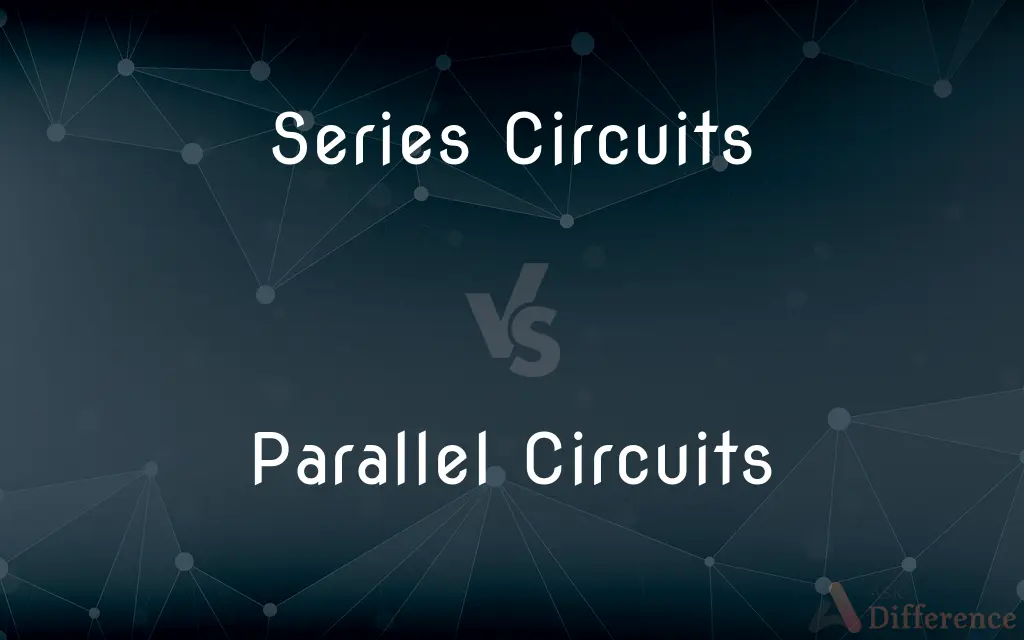Series Circuits vs. Parallel Circuits — What's the Difference?
By Tayyaba Rehman — Published on January 2, 2024
Series circuits have components connected end-to-end, with the same current flowing through each; parallel circuits have components connected across the same voltage points, allowing separate current paths.

Difference Between Series Circuits and Parallel Circuits
Table of Contents
ADVERTISEMENT
Key Differences
In series circuits, components are connected in a single path, so the same current flows through each component sequentially. In contrast, parallel circuits have components connected across common points, allowing different components to carry different current levels simultaneously. This fundamental difference impacts how electrical devices behave when linked in a circuit. If one component fails in a series circuit, the entire circuit is interrupted, while in parallel circuits, other paths remain functional, keeping the remaining components powered.
Voltage drop across each component in series circuits is dependent on its resistance, with the total voltage being the sum of the individual drops. In parallel circuits, the voltage across each path remains the same as the source voltage, regardless of individual component resistance. This distinction affects how electrical devices are designed, with series circuits being useful where a voltage drop is necessary, such as in serial lights, whereas parallel circuits are essential in home wiring to ensure consistent voltage to appliances.
The total resistance in series circuits is the sum of all individual resistances, which leads to a higher overall resistance and less current flow. In parallel circuits, the total resistance is reduced because there are multiple paths for current flow, effectively dividing the total resistance, which allows more current through the circuit. Hence, series circuits are used when limited current is required, while parallel circuits are preferred when devices need more current to operate efficiently.
Power distribution within series circuits can be problematic because a high-resistance component can hog most of the voltage, leaving less for others. On the other hand, parallel circuits ensure that each component can draw the power it needs without affecting the others. This makes series circuits suitable for simple, sequential tasks, while parallel circuits are the backbone of complex and high-power systems like those in buildings and electronic devices.
In troubleshooting, series circuits are simpler to diagnose because the current is the same through all components, so a problem in one area affects the whole circuit. However, parallel circuits can be more complex to troubleshoot, as an issue in one branch may not be immediately apparent due to the uninterrupted function of other branches. Therefore, while series circuits are found in simpler devices for easy maintenance, parallel circuits require more sophisticated methods for problem-solving.
ADVERTISEMENT
Comparison Chart
Current Flow
Same current through all components
Different currents through each component
Voltage Distribution
Voltage divided across components
Same voltage across all paths
Total Resistance
Sum of all resistances, generally higher
Reduced overall resistance
Component Failure
Failure breaks the circuit
Other paths remain functional
Power Distribution
Unequal, depends on component resistance
Equal, each component gets necessary power
Compare with Definitions
Series Circuits
A linear circuit path with a single route for current flow.
He used a series circuit to ensure the voltage drop across each resistor could be measured.
Parallel Circuits
A configuration where voltage is uniform across all parallel branches.
The parallel circuits ensured that all the bulbs received the same voltage.
Series Circuits
A circuit design where component failure means complete circuit disruption.
When the switch broke, the entire series circuit was cut off from the power supply.
Parallel Circuits
An electrical circuit that divides the current into multiple branches.
To prevent overload, he designed parallel circuits across the multiple speakers.
Series Circuits
An arrangement where the total resistance is the sum of individual resistances.
The total resistance of the series circuit increased when he added another resistor.
Parallel Circuits
A design where each component operates independently, unaffected by others in the same circuit.
In the parallel circuits of her home, the kitchen lights stayed on even when the living room lights went out.
Series Circuits
A circuit with electrical components connected one after another.
The Christmas lights stopped working because one bulb in the series circuit burned out.
Parallel Circuits
A circuit where components are connected across two common points, allowing multiple current paths.
Her parallel circuits allowed each processor to operate independently without affecting the others.
Series Circuits
A configuration where the current remains constant across all components.
Despite adding a new LED, the current in the series circuit stayed the same.
Parallel Circuits
An arrangement that reduces total resistance below the smallest individual resistance in the circuit.
Adding more parallel paths in the circuit effectively lowered its total resistance.
Common Curiosities
What is a series circuit?
A series circuit is an electrical circuit in which components are connected end-to-end so that the current flows through each component without branching.
What happens to the total resistance in a series circuit?
The total resistance of a series circuit is the sum of the individual resistances of all components.
Can you add more devices to a series circuit without affecting others?
Adding more devices increases the total resistance, which affects the current through each device.
Are series circuits commonly used in household wiring?
No, series circuits are not typically used in household wiring because of the inconvenience caused if one device fails.
How does voltage distribute in a parallel circuit?
In a parallel circuit, voltage is the same across all branches.
How does voltage distribute in a series circuit?
The total voltage is divided among components in proportion to their resistances.
How does current behave in a series circuit?
In a series circuit, the same current flows through all components.
Is power consumption additive in a series circuit?
Yes, the total power consumption is the sum of the power consumed by each component.
How do you calculate the total voltage in a series circuit?
The total voltage is equal to the sum of the voltages across each component, which equals the source voltage.
What happens if one component in a series circuit fails?
If one component fails, the circuit is broken, and all devices stop working.
What is an example of a series circuit?
A classic example is old Christmas tree lights strung together in a single line.
What defines a series circuit?
A series circuit has components connected end-to-end, with a single path for current flow.
Share Your Discovery

Previous Comparison
Beef Stew vs. Beef Bourguignon
Next Comparison
String Class in Java vs. StringBuffer Class in JavaAuthor Spotlight
Written by
Tayyaba RehmanTayyaba Rehman is a distinguished writer, currently serving as a primary contributor to askdifference.com. As a researcher in semantics and etymology, Tayyaba's passion for the complexity of languages and their distinctions has found a perfect home on the platform. Tayyaba delves into the intricacies of language, distinguishing between commonly confused words and phrases, thereby providing clarity for readers worldwide.














































